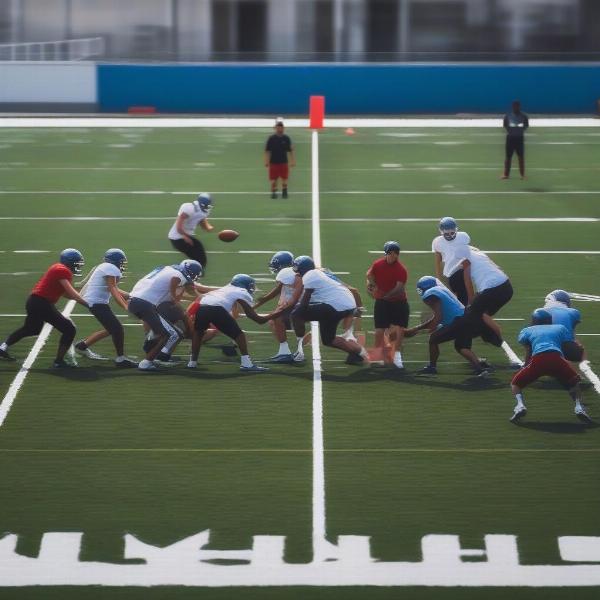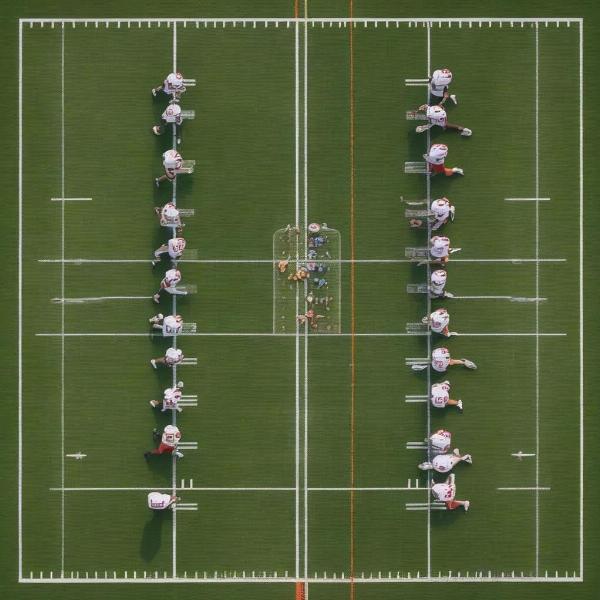Welcome to supremeduelist.blog, where we delve deep into the world of sports and games, providing you with the insights you need. Today we’re tackling a popular variation of American football: the 7 on 7 game. This article will explain what 7 on 7 football is, how it differs from traditional football, and why it’s become such a popular training and competition format. We’ll explore the rules, strategies, and benefits of this fast-paced version of the game.
7 on 7 football is a non-contact version of American football that focuses on passing plays. Unlike traditional 11-on-11 football, 7 on 7 eliminates the offensive and defensive lines, focusing instead on skill positions such as quarterbacks, receivers, and defensive backs. This creates a faster, more agile game that’s ideal for player development, especially in the off-season. This article will dissect the essential elements of 7 on 7 football, helping both players and fans understand its nuances and strategic depth.
Understanding the Basics of 7 on 7 Football
At its core, 7 on 7 football is about refining passing skills and defensive coverage without the physical contact of regular football. The game is typically played on a modified field, often shorter and narrower than a standard football field. This setup speeds up the game and places a premium on agility and quick decision-making. Unlike the full-contact version, there are no running plays, and the emphasis is squarely on the passing game, making it a great way for quarterbacks and receivers to hone their skills. The absence of linemen allows skill players to take center stage.
How 7 on 7 Differs from Traditional Football
The most obvious difference lies in the number of players on the field—seven per side instead of eleven. This key difference leads to many variations in how the game is played. In traditional 11-on-11 football, the offensive and defensive lines play crucial roles. In 7 on 7, the game is more about spacing, timing, and precision passing. There are no tackles, and the play ends when a player is touched with one hand, which emphasizes athleticism and agility. Traditional football involves a full spectrum of offensive and defensive strategies, while 7 on 7 narrows the focus to the passing attack and secondary coverage. If you are curious about other variations of football, you may enjoy looking into iran national under-17 football team games.
 7 on 7 football players on field
7 on 7 football players on field
The Rules of Engagement: Key Regulations in 7 on 7
The rules of 7 on 7 football are designed to ensure a safe and efficient game while maintaining the integrity of American football concepts. The main rules include:
- No Running Plays: This highlights the focus on passing, and it helps develop receivers, defensive backs, and quarterbacks.
- Touch Instead of Tackle: Instead of tackling, defenders touch the offensive player with one hand to stop the play. This reduces the risk of injury and keeps the focus on athletic skills.
- Limited Rushing: The quarterback cannot be rushed until a predetermined count or once the ball is thrown, which is designed to give them enough time to make their throws.
- Modified Field Dimensions: Fields are typically shorter and narrower, which encourages more passing and reduces physical exertion compared to a full football field.
- Time Limits: Game durations are usually shorter and vary based on tournament or league rules.
- Scoring: Standard American football scoring rules usually apply, with touchdowns and extra point conversions.
These rules are fairly straightforward, making 7 on 7 football accessible to players of all skill levels. For anyone interested in other football formats, understanding how they are developed and what they do differently can be helpful. For example, looking at the mali national under-17 football team games can show the variations at a younger level of the game.
Strategic Gameplay in 7 on 7 Football
Despite its reduced format, 7 on 7 football has significant strategic depth. Teams need to have a firm grasp of offensive and defensive schemes to be successful.
Offensive Strategies: Precision and Timing
On offense, the quarterback needs to have a quick release and make accurate throws, and they must work well with their receivers. Route running and timing are essential, as is the ability to create separation from defenders. Here are some key offensive strategies:
- Quick Passes: Short, quick passes help move the chains and keep the defense guessing.
- Play Action: Even though there are no running plays, play-action pass can be a useful tool to get defensive players to move the wrong way, creating openings.
- Route Combinations: Effective route combinations create opportunities to stretch the field vertically and horizontally.
- Reading Defenses: The quarterback’s ability to quickly read defensive coverages is critical to success.
Defensive Strategies: Coverage and Communication
On defense, communication and cohesive coverage are key elements of stopping the opposing team’s passing attack. Defensive backs must read the quarterback’s eyes and react quickly to prevent completions. Here are some key defensive strategies:
- Zone Coverage: Zone coverages allow the team to defend a larger area of the field and force the offense to make mistakes.
- Man Coverage: Playing man-to-man coverage is a strategy that requires excellent technique and anticipation.
- Disguising Coverages: Disguising defensive coverages is a way to confuse the quarterback before the snap and increase the chance for an interception.
- Communication: Communicating switches and hand-offs in coverage is key to avoiding breakdowns and easy completions.
“In 7 on 7, the speed of the game and the need for split-second decisions force players to develop their instincts and sharpen their tactical skills,” says Coach Marcus Thompson, a football analyst and former coach, “It’s a breeding ground for developing high-level football IQ.”
 7 on 7 football defensive strategy
7 on 7 football defensive strategy
The Benefits of Playing 7 on 7 Football
There are many reasons why 7 on 7 football has become a prominent part of player development, ranging from skill enhancement to injury prevention.
Skill Enhancement
7 on 7 is an incredible tool for player development. It is not just for those involved in the 11-on-11 version of the game. Some key areas of improvement are:
- Quarterback Skills: The game forces quarterbacks to make quick decisions and accurate throws under pressure.
- Receiver Skills: Route running, catching, and gaining separation are all improved through 7 on 7 training.
- Defensive Back Skills: Defensive backs sharpen their man and zone coverages.
- Passing Game: The game reinforces the importance of proper passing technique for all players.
Injury Prevention
The non-contact nature of 7 on 7 football drastically reduces the risk of injury compared to traditional full-contact football. This allows players to practice and improve without the fear of collisions.
Off-Season Training
7 on 7 football is a great way for athletes to stay engaged in football during the off-season, and they can use it to maintain a competitive edge. This continuity can be vital for improving consistency when the regular season starts. Just like in any other game, understanding the history and how formats have developed can be insightful; you may consider looking into the 1974 college football all-star game roster.
Team Building
Participating in 7 on 7 provides a great way for teams to build chemistry and communication skills. It encourages players to work together to achieve common goals, which is important whether they are playing games or in practice.
Frequently Asked Questions about 7 on 7 Football
Let’s address some common questions about 7 on 7 football.
What are the field dimensions for 7 on 7?
While exact dimensions can vary, 7 on 7 fields are typically smaller than regulation football fields. Commonly, they are around 40-50 yards long and 30-40 yards wide, often using the width of the field as a constraint.
How long is a 7 on 7 game?
The game length varies but is often shorter than a full football game. A single game might last 30-45 minutes, depending on the league rules and tournament formats.
Can you rush the quarterback in 7 on 7?
Yes, but there are limitations. The quarterback is usually allowed a certain number of seconds before they can be rushed, and these rules can vary slightly from league to league.
What kind of cleats are best for 7 on 7?
Turf shoes or low-cut football cleats are often recommended for 7 on 7 games. These provide good traction on artificial and natural grass surfaces.
Is 7 on 7 only for high school football?
No, 7 on 7 is played at various levels, including youth, high school, and even adult leagues. Its benefits apply to athletes of all ages and skill levels.
“The beauty of 7 on 7 is in its accessibility and the specific skill focus it provides. It’s a great platform for athletes at any level to improve,” notes expert trainer, Jessica Miller, “The absence of the line play means the skills of the other positions get to be the primary focus.” Understanding how different games have evolved helps to appreciate these variations. If you like unblocked games, you can consider looking into 2 minute football unblocked games 76.
Conclusion: Embracing the 7 on 7 Football Experience
In conclusion, 7 on 7 football is a highly valuable variation of American football that provides athletes with a great way to develop their skills, build their football IQ, and compete in a safe environment. Whether you are a player, coach, or a fan, understanding what 7 on 7 football is and its strategic elements can enhance your appreciation for the sport. This format focuses on the passing game, creating a fast-paced environment that improves precision, timing, and defensive coverage.
At supremeduelist.blog, we aim to provide comprehensive insights into the games you love. We hope this deep dive into 7 on 7 football has been valuable. Consider checking out our other articles, such as the ohio state marshall football game for more football related insights. Stay tuned for more in-depth analysis on everything gaming and sports related, and feel free to leave a comment to tell us about your experience with 7 on 7 football.
Leave a Reply